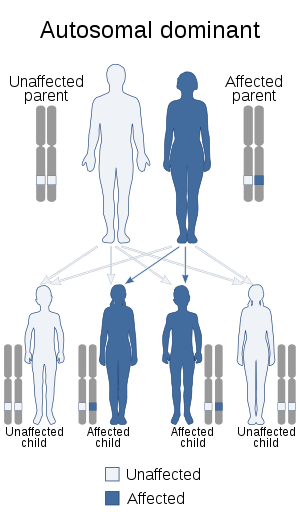Metachondromatosis
Metachondromatosis is an autosomal dominant, [2] incompletely penetrant[3] skeletal disorder affecting the growth of bones, leading to multiple enchondromas and osteochondromas.[3] This tumor syndrome affects mainly tubular bones, though it can also involve the vertebrae, small joints, and flat bones.[4]
| Metachondromatosis | |
|---|---|
| Other names | METCDS[1] |
 | |
| Metachondromatosis has an autosomal dominant pattern of inheritance. | |
Genetics
Metachondromatosis is inherited in an autosomal dominant manner.[3] This means that the defective gene responsible for a disorder is located on an autosome, and only one copy of the gene is sufficient to cause the disorder, when inherited from a parent who has the disorder.
Diagnosis
Treatment
gollark: Inevitably.
gollark: I can create a private channel on irc.osmarks.net or something.
gollark: Perhaps we should just talk textually.
gollark: Oh, and because of the whole inefficient SVG format it would be an overly large SVG.
gollark: Most of the high-power stuff like that is task-specific and only really usable for multiplying big matrices by vectors, and such.
References
- "Metachondromatosis | Genetic and Rare Diseases Information Center (GARD) – an NCATS Program". rarediseases.info.nih.gov. Retrieved 27 June 2019.
- Kennedy LA (1983). "metachondromatosis". Radiology. 148 (1): 117–8. doi:10.1148/radiology.148.1.6602353. PMID 6602353.
- Sobreira NL, Cirulli ET, Avramopoulos D, et al. (2010). "Whole-genome sequencing of a single proband together with linkage analysis identifies a Mendelian disease gene". PLoS Genet. 6 (6): e1000991. doi:10.1371/journal.pgen.1000991. PMC 2887469. PMID 20577567.
- Hunter AG, Kozlowski K, Hochberger O (1995). "Metachondromatosis". Can Assoc Radiol J. 46 (3): 202–8. PMID 7538882.
External links
| Classification | |
|---|---|
| External resources |
This article is issued from Wikipedia. The text is licensed under Creative Commons - Attribution - Sharealike. Additional terms may apply for the media files.